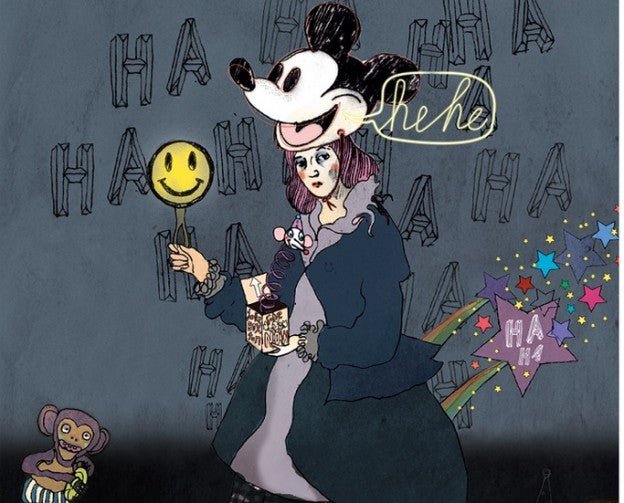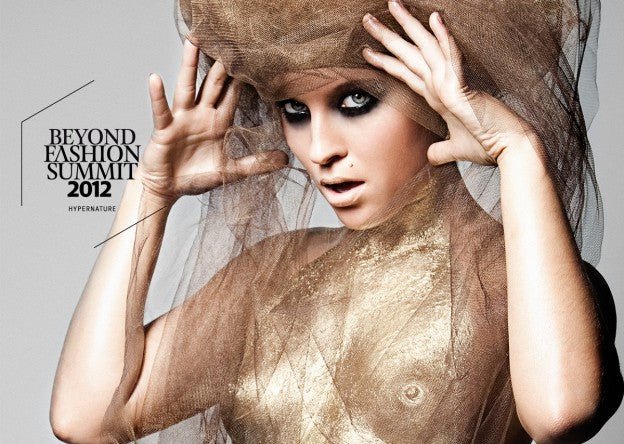Article: Fashion is when you laugh anyway

Fashion is when you laugh anyway
Fredericke Winkler's latest article for J'N'C Magazine . Illustration by Frauke Berg .
If there's one thing we don't want to achieve with our outfits, it's for others to laugh at us. Fashion can be anything: provocative, scandalous, bizarre, strange, even unacceptable. It just can't be funny. Cheerful clothes are so provincial. If an outfit is described as funny, it's a nice euphemism for 'not done well'. If fashion inspires a chuckle, it's long past its prime. Yet – as psychologists and doctors say – humor not only makes us happier and smarter, but also more beautiful. So why does fashion take itself so terribly seriously? Or do we just not understand its jokes?
Recently, I took on the honorable task of being part of a jury evaluating the work of fashion students. Some were good, others less so. What particularly stands out in my memory, however, is a collection whose thoughtless ugliness was almost unsurpassable. Inferior fabrics were sewn together on a sewing machine to create textile structures that seemed neither wearable nor meaningful to me. And while I struggled to control my expression, I listened to the deeply serious babble about the intellectual superstructure of the work, which the student was able to describe with utter eloquence. This situation was by far the funniest I've experienced in a long time. And that's because what was said and what I saw diverged so widely.
"Humor is the sublime in reverse. It degrades the great to place the small alongside it, and elevates the small to place the great alongside it," is the writer Jean Paul's plea to approach things with more cheerfulness. If an evil seems too great to us, we set new standards, 'it could be worse,' and almost everything is put into perspective. Even if the presentation in question is a classic example of unintentional comedy, the absurd idea, in the truest sense of the word, of equating the obviously amateurish collection with genuine quality work nevertheless fascinated me. Why? Because it fundamentally questions the sublimity of fashion.
The situation reminded me of a sketch by Hape Kerkeling for his show 'Total Normal'. In it, Kerkeling portrayed a Polish opera singer performing an experimental piece of music that ended with a loud "hurz." The special flavor of this successful parody of the (pseudo-)intellectual art scene: The audience listened to the performance with benevolent appreciation. Had my student ended his presentation with a loud "hurz," the work would certainly have received top marks. Not as a fashion collection, however, but as an artistic work whose merit would have been to satirize the overly exaggerated seriousness of the industry. After all, fashion must primarily adorn the body and must not—for whatever reason—denigrate it.
From cheerful to fashionable
As a servant of prevailing beauty ideals, fashion cannot risk its sublimity. It functions through the innate human urge to imitate what is 'better'. This is certainly the conclusion reached by anyone who examines Immanuel Kant's 'Anthropological Remarks on Taste', and a reading of Georg Simmel's 'On Fashion' also suggests such an interpretation. Roman Meinhold describes this striving for improvement in 'The Fashion Myth: Lifestyle as the Art of Living' as an act of 'melioration' combined with the goal of aesthetically enhancing the human body. With the help of clothing, people can optimize themselves and thereby enjoy social recognition. For fashion to fulfill its purpose, it must give its wearer the opportunity to beautify themselves according to the understanding of those around them. Comedy, however, is based on breaking the rules, on actively distancing themselves from expectations and social assumptions. A comic person doesn't want to improve themselves; they want to counterpoint. Using language or other means of expression, it points out what it finds debatable. It enjoys senselessness and finds new meaning in it. It brings together things that, at first glance, seem entirely unrelated and uncovers small truths in these absurd structures. According to Duden, humor is an attitude of "cheerful serenity." Serenity in the face of life's adversities.
In short: Humor points to the imperfections in the world, and it helps those with a sense of humor to deal with them with joy. Fashion, however, always strives for perfection. Its purpose is to conceal flaws in order to draw attention to physical virtues. Given this contradictory definition, how can these two principles of representation reconcile?
Life is too short for size zero
First, we must distinguish between the subject who finds something funny and the object or person who appears funny. Fashion doesn't necessarily have to have an obvious sense of humor for us to find it amusing in a certain context. On the contrary, experience shows that deadly serious things are especially begging to be ridiculed. So who's to blame when fashion lacks humor? The wearer, of course. Fashion certainly continues to fulfill its purpose of optimization if it's occasionally tested for its ironic potential and then delivers a good joke.
"Well, all higher humor begins with no longer taking oneself seriously." Hermann Hesse already put this sentence into the mouth of his Pablo in 'Steppenwolf'. So, before you can laugh heartily at others, you must first learn to make fun of yourself. The crux of self-irony? It comes more easily to a Steppenwolf, or rather a so-called fringe group, than to people who see a real chance for themselves to ride the wave of the mainstream. Women with above-average body size in no way jeopardize their option for improvement by wearing a T-shirt with the print 'Life is too short for size zero!' On the contrary. They visibly reject general beauty ideals and make themselves unassailable in terms of dress size, not without the subtle hint that they can shine in other ways. In doing so, they remain committed to the principle of fashion, which is always an interplay of concealment here and display there. However, they lack mass compatibility with fashion. First, the shirt needs the right curves for it to make any sense at all. Second, you have to find its message funny to buy it, and third, you have to have the courage to wear it. The group of people who meet all three criteria is simply too small to constitute a fashion phenomenon.
Textile fun can only arise when a group of people shares a common style and a similar sense of humor, and someone can also knit a collection around it. If the recognition factor is right, it can be successful in enjoying distancing oneself collectively from real and perceived deficits. When the eco-fair label bleed launches a T-shirt with the print 'I can dance my name', it pokes fun at the cliché of the new generation of eco-activists influenced by their parents' alternative lifestyles (keyword: eurythmy lessons at Waldorf schools). The T-shirt is a hit for the young label, which on the one hand suggests that there might actually be some truth to the cliché, and on the other hand points to this milieu's ability to laugh at itself.
"Insofar as fashion seeks to imitate 'worse' people, it becomes a comedy. This certainly doesn't happen often, but it is true, for example, of carnival costumes when people dress up as robbers, prostitutes, clowns, or bums. However, the question must be asked whether these role models don't actually appear 'better' from a particular perspective of the person in the costume; why else would they have dressed up in this particular way? For within the respective social context and within the 'rationality' of the individual's related calculations, the 'worse' person still appears 'better'," says Meinhold, describing the phenomenon of fashionable self-mockery.
Perfectly imperfect
If imperfection is part of a group's aesthetic philosophy, and the humorous approach to it is part of their communication culture, then fashion must even have an ironic undertone. It must find perfection in imperfection so that it can be optimally adorned. This would at least be a fantastic explanation for the success of brands such as Comme des Garçons, Jean Paul Gaultier, or Gareth Pugh. They are known for exaggeration and the deformation of the physical silhouette. A stylistic device with which they question generally accepted conventions of beauty. Perhaps for another reason, the results are often reminiscent of jester costumes, albeit without the clownish awkwardness. And who knows; perhaps Hedi Slimane wet her pants laughing while designing the new Yves Saint... sorry, Saint Laurent collection. Because with it, he - and if we can believe Pierre Bergé - deliberately ensured bad reviews from the press, knowing full well that he would score points with buyers. He would prove to be right, because the veritable relaunch of the traditional company has been enormously successful, which somehow makes the ranting critics look like humorless bunglers, doesn't it? And how exactly should we interpret Emma Hill's beautiful, yet somewhat shaggy collection for Mulberry from last fall/winter, which, according to the designer, was inspired by the children's classic 'Where the Wild Things Are'?
To be aesthetically pleasing, a collection doesn't necessarily have to follow all the rules. It doesn't have to simultaneously conform to physical beauty ideals, seasonal color schemes, and comfort standards. So why not use the opportunity to tell a good joke? If you believe designer Franco Moschino, who was considered a great ironist of high fashion until his untimely death in 1994, there's really only one rule to follow: "Funny fashion has to be extremely well made because then it has the necessary chic. It's easy to be funny with a printed T-shirt, but it's all the more clever to use a mink coat for it. After all, even caviar wouldn't be so interesting if it cost less." (See UK Vogue, August 2009)
When Franco Moschino speaks of 'well made,' he is not only referring to the quality of the workmanship and materials, but also to the design. Because even if it harbors a certain mischievousness, fashion must still serve its purpose. It must therefore neither come across as silly nor sarcastic, but must be responsive to the wearer and charmingly satisfy their need for improvement. Otherwise, fashion would distance itself from the wearer. But fashion is a parasite. If it loses direct contact with its host, it withers like a primrose. A problem that the high-fashion label Prada tackles head-on in the short film 'A Therapy.' The four-minute spot (directed by Roman Polanski!) tells the story of an upper-class lady (Helena Bonham Carter in full Prada regalia) who arrives at her therapist's (Ben Kingsley) home, flops down on the sofa, and starts talking without looking left or right. She fails to notice that her therapist is becoming increasingly distracted by her Prada fur coat on the coat rack. Finally, he can no longer contain himself and slips into the coat himself – an ecstatic moment, which is commented on dryly with the remark: 'Prada suits everyone.' The film sparkles with charming self-irony, yet remains Prada-esquely elegant at every moment, thus winning over not only the fashion brand's customers but also the audience at the Cannes Film Festival.
Karl Lagerfeld manages to effortlessly distance himself from his own weaknesses by regularly poking fun at himself. "Thank God, I can (...) make fun of myself. Which, of course, doesn't stop me from making fun of others," he explained to 'Stern' magazine in December 2006 (No. 51). Since his last appearance on 'Wetten, dass...?' in October 2012, he has been known and loved for his talent for off-the-cuff self-parody. There, when asked whether he liked himself, he replied: "Not that I like myself... But it could be worse." It almost seems as if Karl Lagerfeld had plowed through Sigmund Freud's 1927 work 'Humor', which states the following regarding the meaning and purpose of mocking behavior: "The greatness obviously lies in the triumph of narcissism, in the victoriously asserted invulnerability of the ego. The ego refuses to allow itself to be offended or compelled to suffer by the stimuli of reality; it insists that the traumas of the outside world cannot affect it; indeed, it shows that they are only occasions for derived pleasure. This last trait is absolutely essential to humor." In the case of Karl Lagerfeld, the invulnerability of the ego and the derived pleasure are obviously also transferred to those the King likes to make fun of with such relish. For despite his dry, dry malice, everyone likes to laugh at his jokes, even those he mocks. In an interview with the BZ newspaper on May 28, 2013, he expressed surprise at the public's goodwill, even though he was better known for his "critical words." He felt it was a kind of fool's license to be able to say anything and still be liked. Perhaps he is liked precisely for that reason, and especially because he doesn't exclude himself. In 1905, Freud had already studied jokes in depth. 'Jokes and Their Relation to the Unconscious' is the title of the work in which Freud first examines this technique for generating pleasure and avoiding conflict in more detail. With jokes, we overcome inhibitions, say goodbye to shame and decency, and can indulge in boundless, yet socially acceptable, pleasure for brief moments. We reduce tension and show solidarity with our counterparts, who understand our humor and share the pleasure.
In other words: Humor creates closeness to like-minded people and protects against attacks on one's personality by outsiders. Wouldn't that also be a fantastic definition of fashion? With that in mind, I congratulate the courageous designers who, despite all the seriousness in dealing with the topic, aren't above an ironic wink. A special shout-out to all fashion brands that encourage their fans to take life with cheerful serenity. To everyone else, I recommend shouting "Hurz" out loud at this point. Because if there's one thing we don't want to achieve with our outfits, it's for others to laugh at us. So let's do it ourselves.


Leave a comment
This site is protected by hCaptcha and the hCaptcha Privacy Policy and Terms of Service apply.